To create premium cold-pressed perfume extracts, you'll need to start with late-season Valencia oranges that have rich oil content in their peels. Set up your centrifuge properly with safety protocols, and maintain temps between 60-70°F during extraction and storage. Use amber glass containers with airtight seals, blend complementary oils thoughtfully, and conduct regular quality testing. Expert perfumers know these techniques are just the beginning of crafting exceptional natural fragrances.
The Art of Selecting Premium Citrus Peels for Cold Pressing
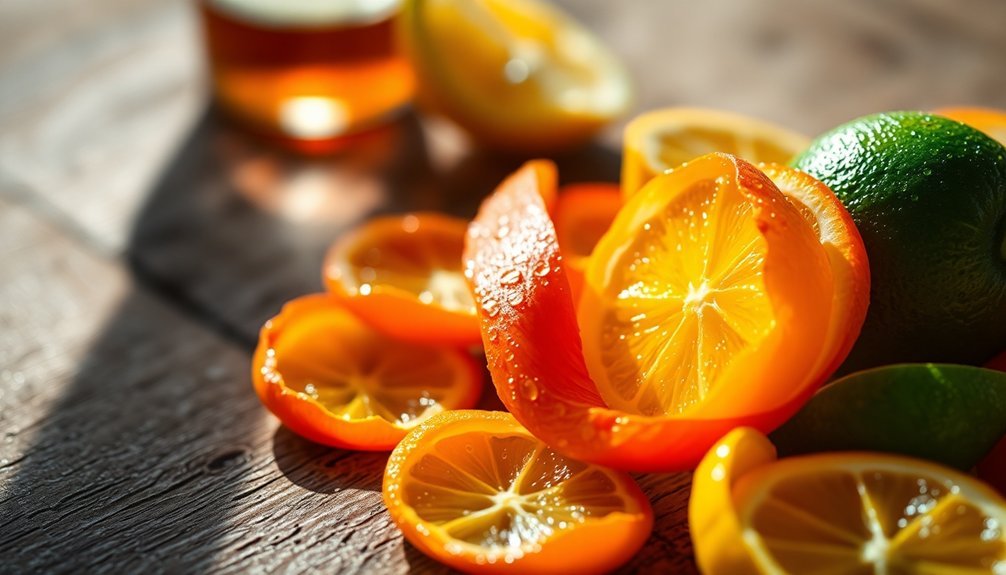
The secret to exceptional cold-pressed citrus oils begins with selecting the perfect fruit. You'll want to focus on Valencia oranges that are almost or freshly ripe, as they're known for their superior oil content and distinctive flavor profile. Late-season fruit from renowned regions like California and Italy typically offers the best results.
When examining the peel, look for ideal thickness and undamaged oil glands. You'll need unblemished, clean peels that haven't been roughly handled during harvest. A high-quality extraction process requires approximately 150 fresh oranges to produce a single 3.4-ounce bottle of premium oil.
Since oil quality diminishes quickly after picking, it's essential to process your citrus immediately. The peel's condition directly impacts your final product's quality and yield, so don't compromise on freshness.
Essential Equipment Setup for Perfect Cold Press Extracts
When setting up your cold press equipment, start by choosing high-grade stainless steel or food-safe glass materials that won't react with citrus oils or compromise extract purity.
You'll need to assemble your centrifuge on a level, stable surface and verify all safety clamps are properly secured before operation. Store your finished extracts in pretty bottles for optimal presentation and preservation.
Remember to wear protective gear, including safety goggles and chemical-resistant gloves, while operating the centrifuge to prevent accidents from high-speed rotation or oil splashes.
Choose Your Press Materials
Professional cold pressing begins with selecting the right equipment and materials for your extraction process.
You'll want to focus primarily on citrus fruits, which contain abundant oils in their peels. Yuzu, lemon, and mandarin oranges are excellent choices, especially when harvested in winter.
For your pressing setup, you'll need either a manual or mechanical press – Italian-engineered machines are particularly effective at preserving natural aromas. This extraction method yields distinctive aromatic properties that differ significantly from other techniques.
Don't forget to include collection vessels and filters in your equipment lineup.
Before pressing, select only the outer peel layer and guarantee it's thoroughly cleaned.
Cut or crush the peels to maximize surface area, then organize them into manageable batches.
Store your prepared peels in a cool, dry place until you're ready to begin the extraction process.
Basic Centrifuge Safety Steps
With your citrus peels prepared, proper centrifuge safety becomes your next key focus for successful cold pressing.
Before starting, you'll need to inspect your equipment thoroughly – check for cracks in tubes, guarantee all bowls are completely dry, and verify that your spindle is clean. Don't forget to apply vacuum grease according to manufacturer specs.
When operating the centrifuge, make sure you're using matched sets of tubes and properly balance the containers in the rotor.
Never exceed the maximum run speed, and always keep the lid closed during operation. You'll need to wait until the rotor has completely stopped before opening – if you're working with any infectious materials, wait an additional 10 minutes.
Use safety cups to contain potential spills, and don't overfill your containers. Report any accidents to your supervisor immediately.
Temperature Control Techniques During Extraction
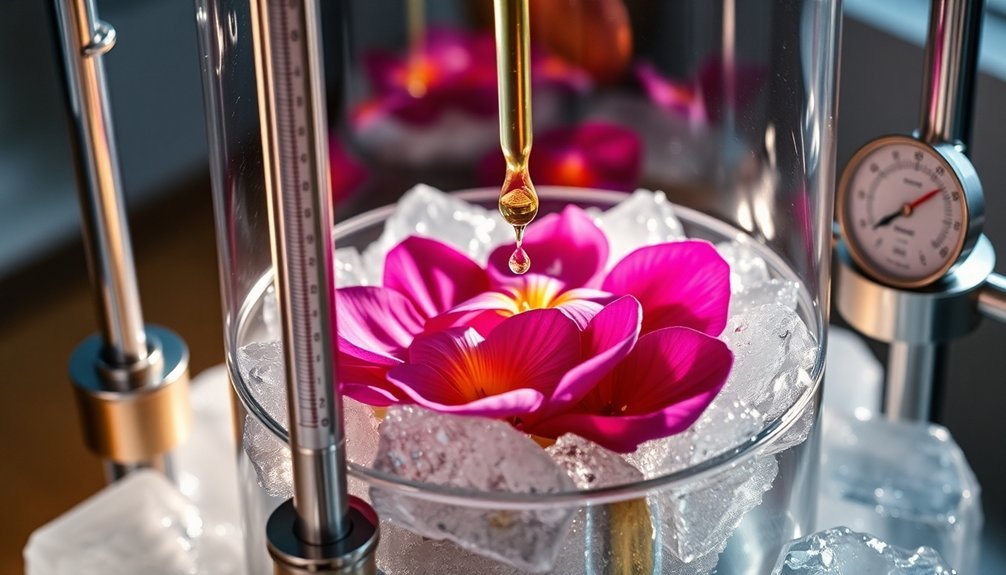
Temperature control serves as a critical factor in natural perfume extraction, determining both the quality and authenticity of the final fragrance.
You'll need to adapt your approach based on your chosen extraction method. For steam distillation, maintain temperatures between 100°C to 105°C to preserve delicate aromatic compounds while ensuring efficient extraction.
If you're working with solvent extraction, you'll want to keep temperatures low, selecting appropriate solvents like hexane or ethanol to protect heat-sensitive compounds.
For citrus-based fragrances, cold-pressing is your best option, as it requires no heat and preserves natural monoterpenes through mechanical extraction.
When using supercritical CO2 extraction, you'll need precise control over both temperature and pressure, typically maintaining lower temperatures to protect volatile substances while adjusting pressure up to 100 atmospheres for ideal results.
Mastering the Five-Minute Processing Window
Although the expression method may appear straightforward, you'll need to work within a critical five-minute window to achieve ideal extraction results.
During this brief period, you'll press either whole citrus fruits or peels using modern equipment like the pelatrice, followed by immediate centrifuge separation.
You can't delay the process between pressing and separation, as this guarantees you'll capture the most authentic aroma compounds from your citrus materials.
Unlike traditional methods such as sponge extraction, you're now able to work efficiently with specialized machinery that maintains the natural fragrance profile.
When you properly execute this time-sensitive process, you'll produce high-quality essential oils without using heat or water vapor, making it ideal for creating ultra-realistic citrus notes in perfumes.
Proper Storage Methods to Preserve Aromatic Compounds
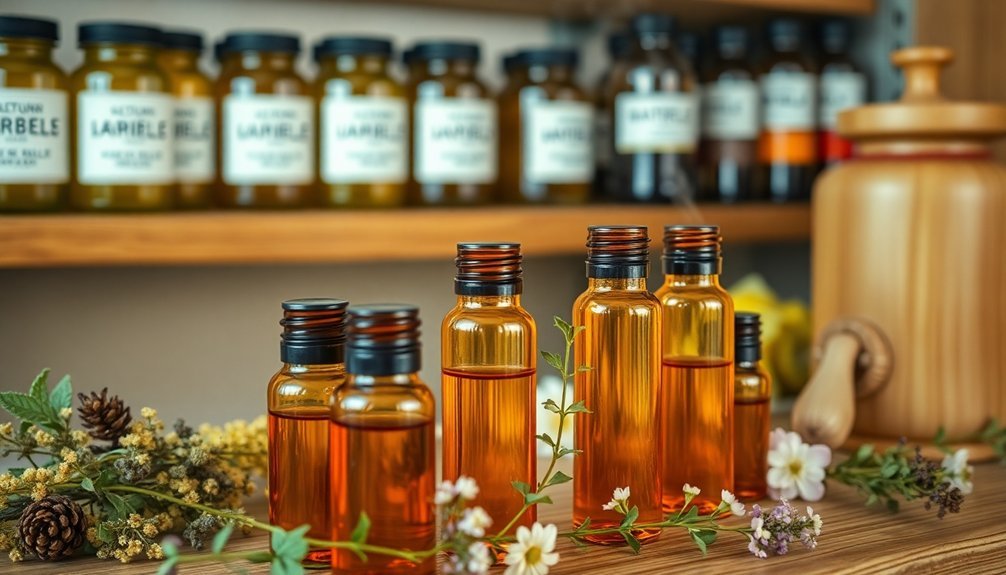
You'll need to store your cold-pressed perfume extracts in airtight glass containers to protect their aromatic compounds from oxidation and degradation.
Secure your extracts with tight-fitting lids that create an effective barrier against air infiltration, and consider using amber or cobalt blue glass for added UV protection.
Keep your stored extracts at a consistent temperature between 60-70°F to maintain their potency and prevent the breakdown of precious aromatic molecules.
Airtight Containers Matter Most
The three most essential elements of proper perfume storage revolve around airtightness, light protection, and container material.
You'll want to prioritize airtight containers above all else, as they prevent oxidation and evaporation that can quickly degrade your natural perfume extracts.
Choose glass containers with secure seals, as they're non-reactive and won't contaminate your fragrances like plastic can.
You'll find dark-colored glass, such as amber or cobalt blue, offers the best protection against harmful UV rays that break down aromatic compounds.
Don't underestimate the importance of proper storage – plastic containers might seem convenient, but they're permeable and can create static electricity that affects your perfume's quality.
Temperature Control During Storage
Maintaining proper temperature control stands as a critical factor in preserving your natural perfume extracts and aromatic compounds. You'll want to keep your fragrances between 15-20°C (59-68°F) for ideal preservation. Avoid storing them above 70°F, as this can trigger rapid evaporation and alter their scent profiles.
| Storage Location | Temperature | Benefits |
|---|---|---|
| Cool Basement | 13-15°C | Stable environment |
| Interior Closet | 15-20°C | Limited fluctuation |
| Cabinet | 15-18°C | Controlled setting |
Choose a dedicated storage space away from heat sources and direct sunlight. Don't move your perfumes between different environments, as temperature fluctuations can cause fragrance molecules to expand and contract. Consider using a temperature-controlled cabinet or cool closet to maintain consistent conditions. Monitor your storage area with a thermometer to guarantee ideal preservation of your aromatic compounds.
Blending Cold Pressed Oils With Other Natural Extracts
When crafting natural perfumes, blending cold-pressed oils with other extracts requires careful attention to balance and compatibility.
Start by selecting complementary oils that enhance each other's aromatic profiles while considering the top, middle, and base notes of your blend.
You'll want to use cold-pressed oils as carrier bases, which can help stabilize and extend the life of essential oils while adding their own subtle fragrances.
Begin with small amounts, testing different proportions until you achieve your desired scent. Try combining contrasting elements, like pairing citrus with earthy notes, or create harmony by matching similar scent families.
Don't forget to patch test your blend on a small area of skin before full application.
You can create seasonal variations by adjusting the ratios of oils and experimenting with different natural extract combinations.
Quality Testing Your Cold Pressed Perfume Ingredients
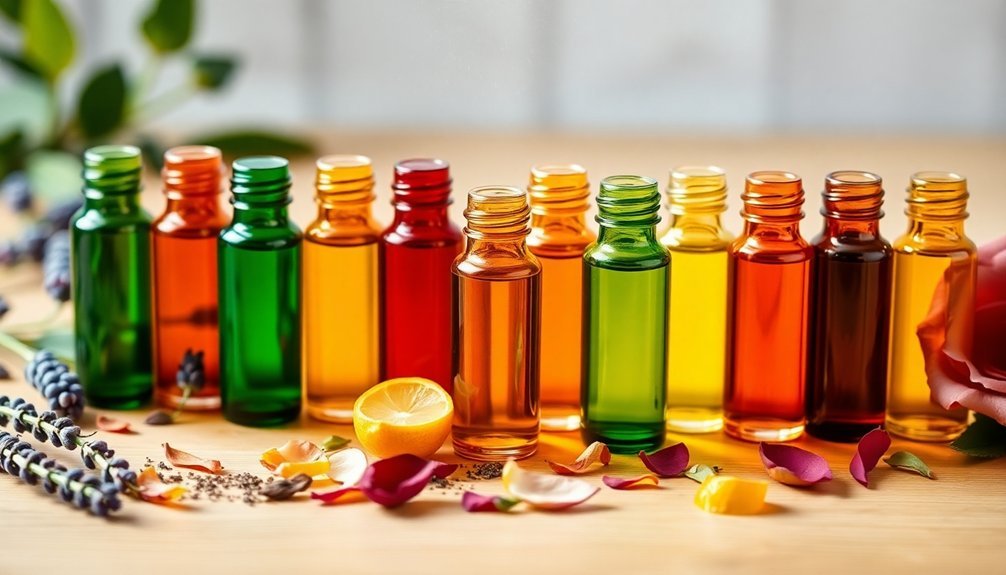
Quality testing stands as a cornerstone of creating exceptional natural perfumes from cold-pressed ingredients.
You'll need to authenticate your ingredients through rigorous supplier verification and obtain certificates of analysis for each component. Test every batch of your cold-pressed oils using GC-MS analysis to confirm their chemical profiles and verify there aren't any adulterants present.
For peak results, you'll want to conduct stability testing by exposing your perfume blends to various temperatures and light conditions.
Don't skip the freeze-thaw cycles, as they'll reveal how your fragrance holds up under extreme conditions. Perform regular sensory evaluations with expert perfumers to verify that your cold-pressed ingredients maintain their intended olfactory profiles.
Remember to document all test results, including batch numbers and supplier information, to maintain consistent quality across your natural perfume production.
Frequently Asked Questions
Can Cold Pressing Be Adapted for Non-Citrus Fruits With High Oil Content?
You can adapt cold pressing for non-citrus fruits with high oil content like avocados, but you'll need specialized equipment and methods to handle their unique pulp structure and oil distribution effectively.
How Do Seasonal Variations Affect the Quality of Cold-Pressed Citrus Oils?
You'll notice significant quality variations in cold-pressed citrus oils across seasons. Weather, ripeness, and harvest timing affect the oils' volatile compounds, fragrance profiles, and stability. Climate changes can impact your oil's overall potency.
What Causes Cloudiness in Cold-Pressed Oils and How Can It Be Prevented?
You'll notice cloudiness in cold-pressed oils due to temperature changes, light exposure, and natural sediments. To prevent this, store your oils in dark bottles at room temperature and avoid refrigeration or basement storage.
Does the Age of Citrus Fruits Impact the Yield of Essential Oils?
Yes, your citrus fruit's age directly affects oil yields. You'll get better yields at specific maturity stages: lemons yield more when immature, sour oranges when mature, and mandarins and oranges at semi-mature stages.
Can Cold-Pressed Oils Be Safely Mixed With Synthetic Fragrance Compounds?
You shouldn't mix cold-pressed oils with synthetic fragrances due to potential chemical reactions, health risks, and stability issues. If you need fragrance enhancement, stick to natural essential oils for safer results.
In Summary
Now you're ready to create your own signature cold-pressed perfume extracts. Remember to start with fresh, unblemished citrus peels, maintain precise temperature control, and work within that vital five-minute window. Don't forget to properly store your precious oils in dark glass containers away from light and heat. Test each batch for quality, and you'll soon master the art of natural perfume making.

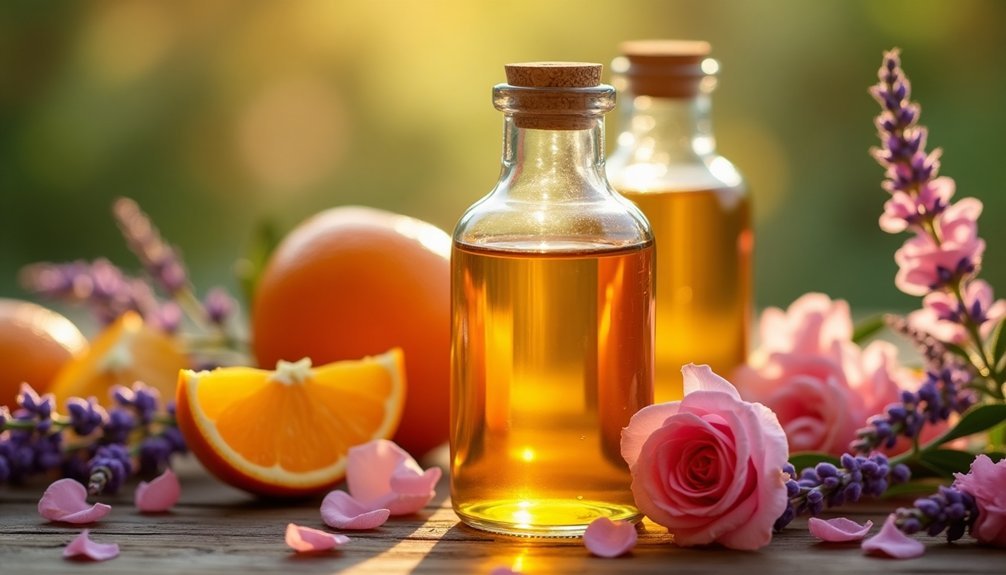



Leave a Reply